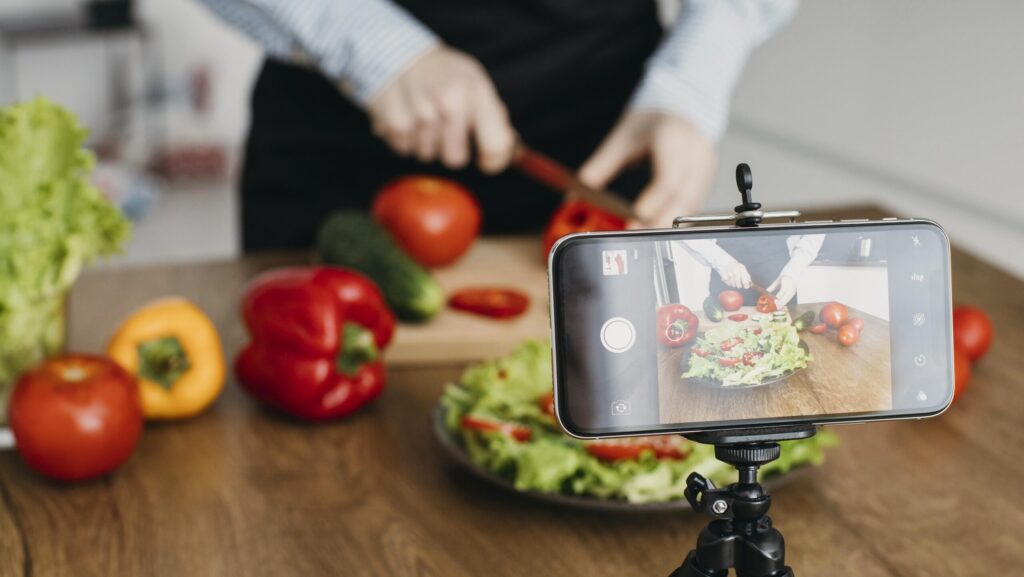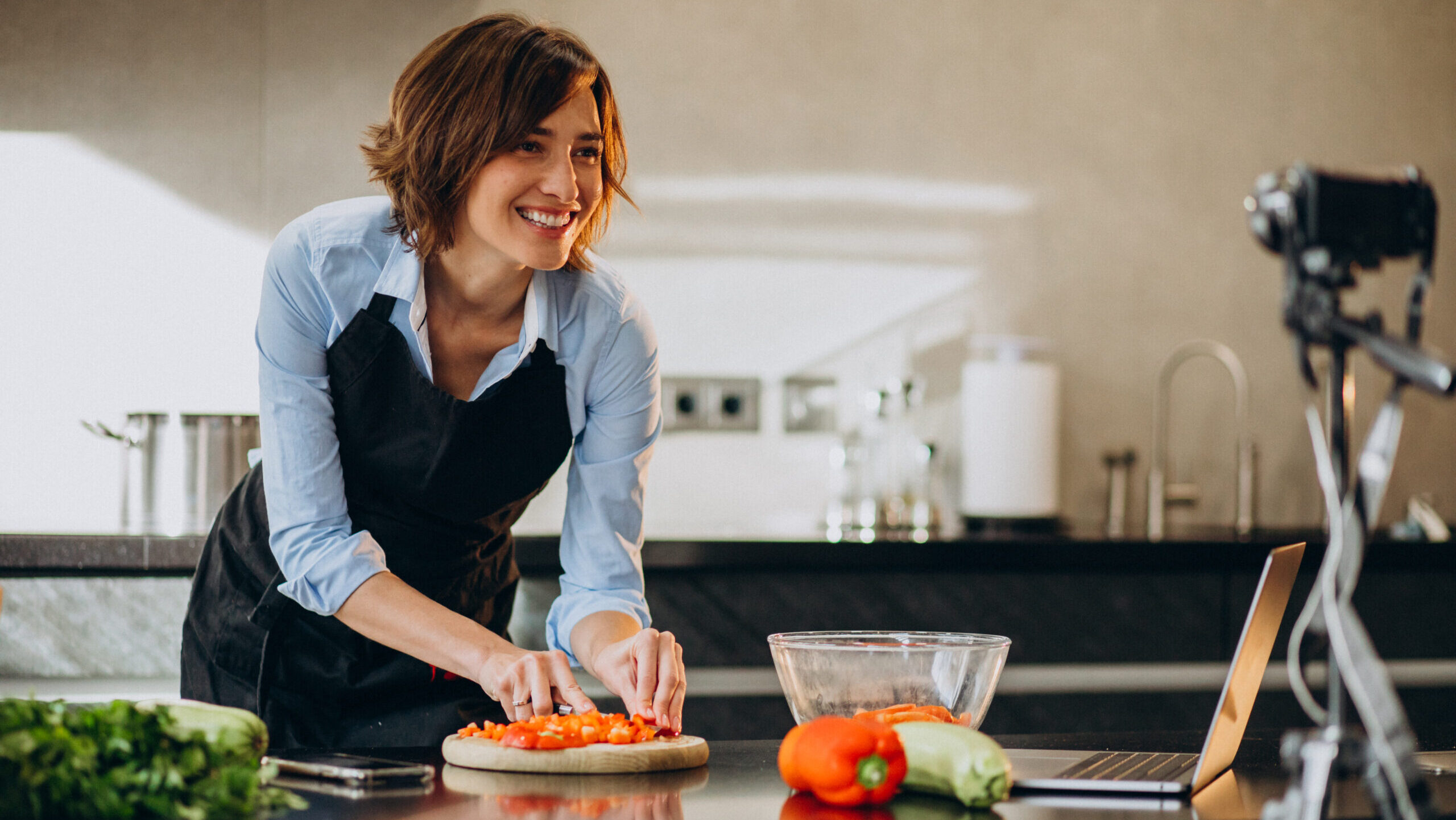Have you ever dreamed of turning your culinary passion into a thriving online presence? Learning how to start a food blog can be an exciting journey that allows you to share your recipes, food adventures, and kitchen tips with a global audience. From mastering food photography to crafting mouthwatering content, food blogging offers a delicious blend of creativity and culinary expertise.
As you embark on your food blogging adventure, you’ll discover the importance of finding your niche, developing a consistent posting schedule and engaging with your readers through social media platforms like Pinterest. You’ll also learn to use tools such as WordPress and Google Analytics to create a user-friendly website and track your blog’s performance. Whether you’re looking to share your love for cooking or aiming to monetize your culinary skills, this guide will help you plate up success in the digital world.
Choose Your Food Blog Niche
Starting a food blog is an exciting way to share your culinary adventures and turn your passion into a potentially profitable venture. At the heart of every successful food blog lies a genuine passion that resonates with its audience, translating into engaging and inspiring content. To set yourself up for success, you need to identify your culinary strengths and interests, which will help you choose the right niche for your blog.
Define your culinary focus
To begin, you need to assess your culinary passions and expertise.
Ask yourself:
- What type of food do you enjoy cooking the most?
- Are there specific dietary criteria you often cater to, such as dairy-free or low-carb meals?
- Do you have a treasure trove of family recipes tied to a particular cuisine that could captivate an audience looking for authenticity and tradition?
Your niche should reflect your interests and skills, not blindly follow trends.
A blog centred around genuine passion sustains an audience’s interest and allows for the use of targeted keywords, which is crucial to improve search engine rankings and drive traffic.
Research popular food blog niches
Once you’ve identified your personal culinary leanings, it’s time to analyse the market to understand where your interests could fit best.
Here are some popular food blog niches to consider: Ethnic cuisine, such as Chinese, Italian, or Middle Eastern, offers a diverse range of flavors and cultural experiences. Dietary-specific recipes cater to those with special needs or preferences, including gluten-free, vegan and vegetarian options. Cooking methods like Instant Pot recipes or BBQ techniques appeal to those interested in specific culinary approaches. Focusing on specific dish types, such as desserts or smoothies, allows for specialization in a particular area. Health-conscious eating blogs address the growing interest in nutritious and balanced meals. Budget-friendly recipes help readers create delicious meals without breaking the bank. Coffee enthusiasts can explore a niche dedicated to all things coffee, from brewing techniques to bean varieties.
To gain insights into what people are currently interested in, use tools like Google Trends. Social media platforms are also rich with data – hashtags, forums, and existing blogs can show you what’s trending and what’s not. This investigation helps in identifying niches that are oversaturated and those that still have room for a new voice.
Align niche with your passion and expertise
Blogging, especially in a content-rich field like food, is a long-term commitment. Your niche should be something you’re passionate about, keeping you motivated to create content even when growth seems slow. Consider drilling down further to find a ‘niche within a niche.’ For instance, instead of just focusing on gluten-free recipes, you could specialise in gluten-free baby food.
When looking at potential niches, consider the quality of existing content. Is there a high level of engagement? Are the current blogs or forums well-monetized? Assessing the competition helps you understand who is out there and determine if you can outperform them. This could be through higher-quality content, more engaging multimedia integration or a fresher perspective.
Remember, finding your niche helps you stand out and connect with the right audience. A well-defined niche allows you to:
- Build a community of like-minded individuals who engage with your content
- Create targeted content that resonates with your specific audience
- Improve your search engine rankings through focused keywords
Attract advertisers and sponsors looking for niche blogs with dedicated audiences
By choosing a niche that aligns with your passion and expertise, you’ll be better equipped to create compelling content consistently. This approach narrows your audience but increases your appeal to that specific group, allowing for more targeted content and potentially higher engagement rates.
To sum up, choosing the right food blog niche involves a mix of personal reflexion and market analysis. It’s about finding that sweet spot where your culinary interests intersect with market demand and your ability to provide unique, valuable content. With a well-defined niche, you’ll be on your way to creating a food blog that not only satisfies your creative appetite but also serves up success in the digital world.
Create Compelling Content
To start a successful food blog, you need to create content that captivates your audience and keeps them coming back for more. This involves developing your unique voice, writing engaging recipe posts, and crafting informative articles. Let’s explore these aspects in detail.
Develop your unique voice
Your unique voice is what sets you apart from other food bloggers. It’s the way you communicate with your readers, sharing your passion and expertise.
To develop your voice, focus on being authentic by writing as if you’re speaking to a close friend or family member. Your natural way of expressing yourself is what makes your content unique. Share personal stories to connect your recipes to memories, travel experiences or family traditions, adding depth to your content and helping readers relate to you on a personal level. Don’t be afraid to let your quirks and humor shine through; if you’re naturally funny, incorporate that into your writing. Show your personality and be honest by sharing both your successes and failures in the kitchen. Readers appreciate authenticity and can learn from your experiences, making your content more engaging and relatable.
Remember, your voice should reflect your niche and what makes you stand out in the crowded food blogging space.
Write engaging recipe posts
Your recipe posts are the heart of your food blog. Here’s how to make them engaging and informative:
- Start with a hook: Begin your post with an interesting anecdote, a description of the dish’s aroma or why this recipe is special to you.
- Describe the recipe: Explain why you love it, how you developed it and what makes it unique.
- Provide clear instructions: Break down the cooking process into easy-to-follow steps. Include tips for success and potential pitfalls to avoid.
- Use descriptive language: Paint a picture with your words. Describe textures, flavours and aromas to make your readers’ mouths water.
- Include helpful information: Mention ingredient substitutions, variations for dietary restrictions and storage instructions.
- Add visual aids: Incorporate step-by-step photos or videos for complex techniques.
- End with a call-to-action: Encourage readers to try the recipe and share their results with you.
Craft informative articles
In addition to recipes, informative articles can add value to your blog and establish your expertise.
Explore a variety of engaging topics to enrich your food blog. Dive into ingredient spotlights, showcasing seasonal produce, exotic finds and pantry essentials while detailing their nutritional benefits, selection tips, storage methods and versatile culinary applications. Craft comprehensive guides on diverse cooking techniques, knife skills and the proper use of kitchen equipment to help your readers enhance their culinary prowess. Delve into the fascinating world of food and culture, uncovering the historical roots and cultural significance of various dishes and cuisines. Share valuable insights on nutrition and health, offering well-researched articles about balanced eating, effective meal planning, and specific dietary approaches. Provide practical kitchen wisdom through tips and tricks, covering essential topics such as efficient meal prep strategies, innovative ways to reduce food waste, and smart kitchen organization techniques. By incorporating these diverse themes, you’ll create a rich tapestry of content that informs, inspires, and engages your food-loving audience.
When crafting these articles:
- Research thoroughly to ensure accuracy
- Use clear, concise language
- Break up text with subheadings, bullet points, and images
- Include relevant internal and external links to provide additional value
Remember, the goal is to make your content as helpful and engaging as possible for your readers. By developing your unique voice, writing compelling recipe posts and crafting informative articles, you’ll create a food blog that not only showcases your culinary skills but also connects with your audience on a deeper level. This approach will help you stand out in the crowded food blogging space and build a loyal following.

Master Food Photography
To create a successful food blog, you need to capture mouthwatering images that make your readers’ stomachs growl. Mastering food photography is essential to stand out in the crowded food blogging space. Here are some key aspects to focus on:
Invest in quality equipment
While you don’t need top-of-the-line gear to start, investing in some basic equipment can significantly improve your food photography.
- Camera: You don’t need an expensive camera to begin. A second-hand DSLR or a mirrorless camera can work wonders. If you’re on a tight budget, even a smartphone with a good camera can suffice for starting out.
- Lenses: For crop sensor cameras, a 35mm lens is ideal. If you have a full-frame camera, opt for a 50mm lens. Look for lenses with a high aperture of f/1.8 to handle low-light conditions effectively.
- Tripod: As you progress, a sturdy tripod becomes essential. Look for one with good height, an overhead arm, and the ability to handle a considerable payload.
- Lighting: Natural light is your best friend when starting out. It’s free and beautiful. However, invest in a diffuser to help tame harsh natural light. As you advance, consider continuous lighting options like the Godox SL60 for more control.
- Backdrops and props: Invest in subtle, textured backdrops and smaller props to add depth and interest to your images without overwhelming the food.
Learn food styling techniques
Food styling is an art that can significantly impact the quality of your images. To enhance your food photography, consider employing various techniques. The rule of odds suggests arranging props or food in odd numbers for a more visually appealing composition. Creating depth by layering your scene with props like napkins, plates, and bowls adds dimension to your images. Adding garnishes such as fresh herbs, spices, or ingredients from the recipe introduces pops of colour and interest to your dishes. Styling with smaller, carefully arranged portions often results in a more attractive presentation compared to large mounds of food. Creating a lived-in look by adding crumbs, spills, or sprinkles can make your scene appear more natural and inviting. Using fake ice cubes can help prop up food items or create the illusion of a fuller bowl. Finally, adding water droplets with a spray bottle to glasses or fruits can make them appear more appetising and fresh.
Edit photos professionally
Post-processing is crucial in food photography. To elevate your images through editing, start by shooting in RAW format, which captures all image data and gives you more control during editing. Use professional software like Adobe Lightroom and Photoshop, which are industry standards. While there’s a learning curve, they offer powerful editing capabilities. Begin by adjusting exposure and white balance to ensure your food looks natural and appetising. Enhance colours using the HSL (Hue, Saturation, Luminance) sliders to balance and enhance colours without making them look unnatural. Add contrast by using the tone curve to create a soft ‘S’ shape, brightening highlights and darkening shadows for added depth. Apply sharpening as your final step, but be careful not to overdo it, which can make food look unappetizing. Finally, develop a consistent editing style to give your food blog a cohesive look. By following these post-processing techniques, you can significantly improve the quality and appeal of your food photographs.
Remember, the goal of food photography is to make the viewer want to eat the food. As you practise these techniques, always ask yourself, “Does this image make me hungry?” If the answer is yes, you’re on the right track. With time and practise, you’ll develop your unique style and create stunning images that will make your food blog irresistible to readers.
Promote Your Food Blog
Utilise social media platforms
To get your food blog noticed, you need to harness the power of social media. These platforms are essential for reaching new audiences and driving traffic to your site. Instagram is a fantastic resource for food bloggers, allowing you to share mouthwatering photos and personal insights. It’s one of the easiest networks to gain followers on, especially if you use plenty of hashtags. This strategy helps new people discover your posts and follow you.
Pinterest is another excellent platform for sharing your recipes and pages. It’s also a great way for your site visitors to share your content with their followers. To make sharing effortless, consider adding social media icons to your pages.
Facebook can be a valuable tool for sharing new posts. Create a page for your blog, add some information about it, and you’re ready to go. One of the benefits of Facebook pages is that you can see how many people have viewed your posts and even boost them for a small fee to reach a wider audience.
While X (Twitter) might not be everyone’s cup of tea, many bloggers have found success with it. If your blog focuses more on stories than pictures, X can be an excellent way to share previews of your posts.
Don’t forget about YouTube. While it might not be a traditional social network, it’s a great platform for food bloggers. Videos, especially sped-up cooking demonstrations, can add a new dimension to your content and engage your audience in a different way.
Network with other food bloggers
Connecting with other bloggers in your niche can have a significant impact on your blog’s growth. Networking offers numerous benefits, including referral traffic, learning opportunities, and potential partnerships.
One effective way to start networking is by joining blogging groups and communities. These spaces allow you to connect with like-minded individuals, share experiences, and learn from others. Consider joining Facebook groups dedicated to food blogging or broader blogging communities.
Guest posting is another fantastic way to build relationships with other bloggers while expanding your reach. Look for opportunities to contribute to other food blogs, and be open to hosting guest posts on your site as well. This exchange can lead to valuable backlinks, increased exposure, and new readers.
Attending blogging events is an excellent way to meet other bloggers in person. Look for food blogging conferences or broader blogging events in your area. These gatherings provide opportunities to learn, network and potentially form lasting friendships with other bloggers.
Don’t underestimate the power of engaging with other bloggers through their content. Leave thoughtful comments on their posts, share their content on social media, and interact with them regularly. This consistent engagement can help you build genuine relationships over time.
Implement SEO best practises
Search Engine Optimisation (SEO) is crucial for increasing your blog’s visibility in search results. By implementing SEO best practises, you can potentially see a significant increase in traffic to your site.
Start by conducting keyword research to identify terms and phrases your target audience is searching for. Tools like Google Keyword Planner or paid options like SEMrush can help you find relevant keywords with decent search volume and manageable competition.
Once you’ve identified your keywords, incorporate them naturally throughout your content. Include them in your title tags, meta descriptions, headings, and body text. Remember, moderation is key – your content should still read naturally and provide value to your readers.
Consider creating recipe clusters to boost your SEO impact. Group related recipes together, linking between them and creating a dedicated page or post for the complete cluster. This approach can help search engines recognise the relevance and interconnectedness of your content.
Optimise your images and videos for SEO as well. Use descriptive file names and alt tags for your images, and ensure your video titles and descriptions are keyword-rich and accurate.
Lastly, don’t forget about internal linking. Connect your content through relevant hyperlinks, guiding readers (and search engines) to related recipes and posts on your site.
By consistently applying these promotion strategies – leveraging social media, networking with other bloggers, and implementing SEO best practises – you’ll be well on your way to growing your food blog’s audience and establishing your online presence in the culinary world.
Develop a Content Strategy
To create a successful food blog, you need to develop a robust content strategy. This involves planning your content calendar, writing captivating recipe posts and creating engaging food-related articles. Let’s explore these aspects in detail.
Plan your content calendar
Planning your content calendar is crucial for maintaining a consistent posting schedule and keeping your blog fresh and engaging. Start by deciding how many posts you want to publish per week and how many weeks you’ll be posting throughout the year. Don’t forget to factor in any time off for holidays or vacations.
To make the most of your time, consider batching your content creation. This involves dedicating specific days to recipe development, photography or writing. By focusing on one task at a time, you can build momentum and stay in a productive mindset. When planning your content, think about seasonal themes and holidays. Group similar recipes together for efficient batch cooking and photography sessions. For example, you could shoot several pasta dishes in one session, creating content for multiple posts. Use a tool that works for you to manage your content calendar. This could be as simple as Google Calendar or a more specialised tool like CoSchedule or Asana. The key is to choose a system that you’ll actually use and stick to.
Create engaging food-related articles
In addition to recipes, create engaging articles that provide value to your readers. Consider writing about ingredient spotlights, eco-friendly cooking tips, or restaurant reviews. These posts can help diversify your content and appeal to a broader audience.
When writing these articles, maintain a consistent tone that aligns with your blog’s identity. Whether it’s casual and conversational or more formal and authoritative, keep it uniform throughout your posts.
Remember to optimise your content for search engines. Use relevant keywords naturally throughout your post, including in your title, headings, and body text. This can help improve your blog’s visibility in search results.
By implementing these strategies, you’ll be well on your way to creating a food blog that not only showcases your culinary skills but also engages and grows your audience. Remember, consistency is key. Stick to your content calendar, keep refining your writing skills, and always strive to provide value to your readers. With time and dedication, you’ll see your food blog flourish and attract a loyal following of food enthusiasts.
Optimise for Search Engines
To start a food blog that stands out in the digital culinary world, you need to master the art of Search Engine Optimisation (SEO). By implementing effective SEO strategies, you can significantly increase your blog’s visibility and attract more organic traffic. Let’s explore some key techniques to optimise your food blog for search engines.
Conduct keyword research
Keyword research is the foundation of any successful SEO strategy. It helps you understand what your target audience is searching for and allows you to create content that meets their needs. To begin, identify your blog’s niche and audience. Are you focusing on vegan desserts, quick family dinners, or exotic cuisines? Once you’ve pinpointed your theme, it’s time to cook up some broad keyword search terms.
Start by using free tools like Google Keyword Planner or Ubersuggest to generate keyword ideas. These tools can help you find relevant keywords with decent search volume and manageable competition. Don’t forget to explore long-tail keywords, which are more specific phrases that can help you target niche audiences. For example, instead of targeting “cake recipe,” you might focus on “low-sugar chocolate lava cake recipe.”
When conducting keyword research, consider the search intent behind each keyword. Are users looking for quick recipes, detailed guides, or product reviews? Understanding the purpose behind searches can help you create content that better satisfies user needs.
Implement on-page SEO techniques
Once you’ve identified your target keywords, it’s time to implement on-page SEO techniques. These strategies help search engines understand your content and improve your chances of ranking higher in search results.
- Optimise your titles and headings: Include your target keyword in your post title, recipe title, and relevant headings throughout your content.
- Create compelling meta descriptions: Write enticing meta descriptions that include your target keyword and encourage users to click through to your site. Use descriptive image file names and alt text: Rename your images with relevant, keyword-rich file names and add descriptive alt text to help search engines understand your visual content.Optimise your content: Naturally incorporate your target keyword and related terms throughout your blog post. Aim for a keyword density of around 2% to avoid keyword stuffing.
- Implement schema markup: Use a WordPress recipe plugin like Tasty Recipes to add structured data to your recipes, making it easier for search engines to understand and display your content in rich snippets.
- Internal linking: Connect your content by adding relevant internal links to other posts on your blog. This helps search engines understand the structure of your site and can improve user engagement.
Build quality backlinks
Backlinks or links from other websites to your blog, are a crucial factor in search engine rankings. The more high-quality backlinks you have, the more authoritative your site appears to search engines.
To build quality backlinks for your food blog, consider implementing a variety of strategies. Start by creating valuable content that other bloggers and websites will naturally want to link to, such as high-quality, informative articles. Reach out to fellow food bloggers and offer to write guest posts for their sites, which can help you gain exposure and earn valuable backlinks. Engage with the food blogging community by participating in forums, leaving thoughtful comments on other blogs, and joining food blog networks like Yummly or Foodista.com to increase your visibility and potentially earn more backlinks. While social media links may not directly impact SEO, leveraging platforms like Facebook, Twitter, and Pinterest can help increase your overall online presence and engagement with your audience. Finally, consider creating shareable content such as infographics, videos or presentations based on your recipes or food-related topics. Sharing these on platforms like YouTube, SlideShare, or Pinterest can help you earn backlinks and expand your reach in the food blogging community.
Remember, building a successful food blog takes time and effort. Consistently apply these SEO strategies, monitor your progress using tools like Google Analytics and Google Search Console, and be patient. With persistence and high-quality content, you’ll see your food blog climb the search engine rankings and attract a loyal following of food enthusiasts.
Final Thoughts
Starting a food blog is an exciting journey that blends culinary passion with digital creativity. By choosing a niche that aligns with your interests, creating compelling content, mastering food photography, and promoting your blog effectively, you can turn your love for food into a thriving online presence. Remember, consistency is key in building your audience and establishing your unique voice in the crowded food blogging space.
As you embark on this delicious adventure, keep in mind that success doesn’t happen overnight. It takes time to grow your following, refine your skills, and find your place in the food blogging community. Stay patient, keep learning, and most importantly, have fun with it. Your authentic passion for food will shine through your content, attracting readers who share your culinary enthusiasm and helping you create a food blog that stands out from the rest.



